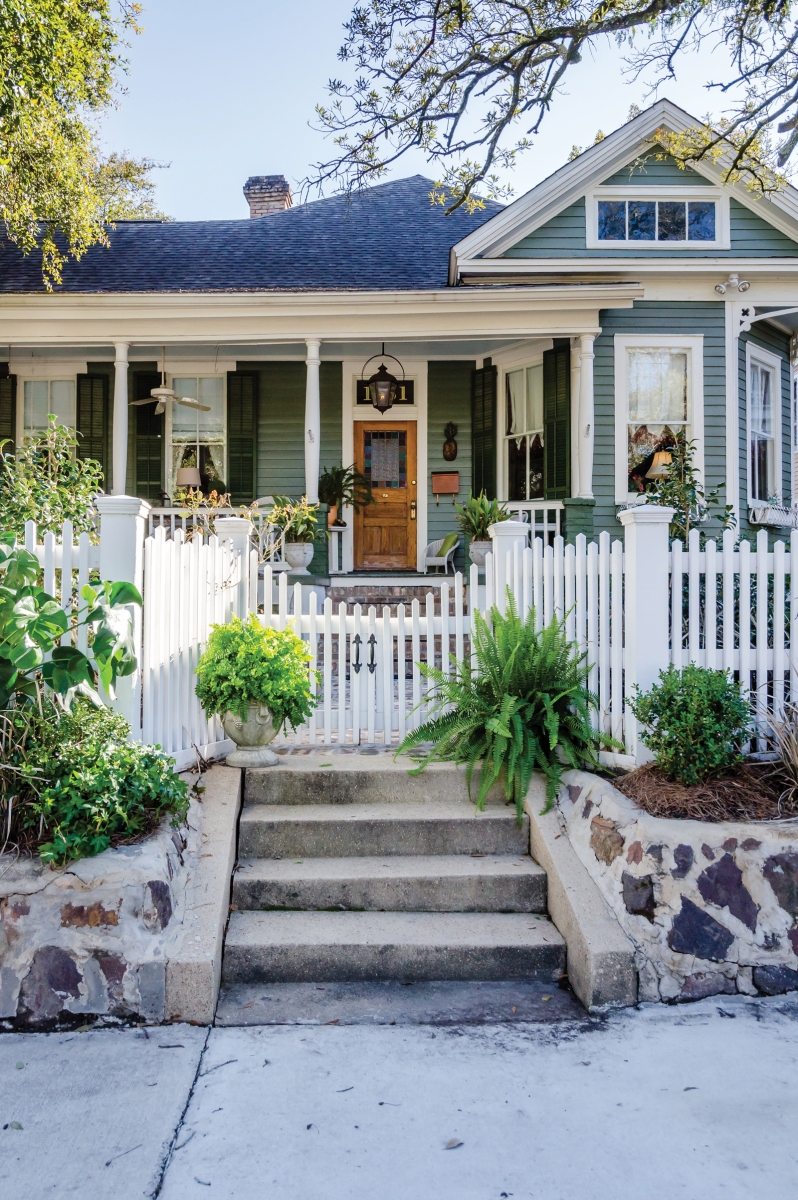
ABOVE A picket fence along the boardwalk in Point Clear shows the trend for thick brick bases with white pickets on top. Fence posts and gates can be accented with finials, trims and decorative details to make even a do-it-yourself fence look swank. Simple copper post caps are a nice finishing touch.
Nothing quite symbolizes the American Dream like a crisp, white picket fence. This architectural line in the sand has been a part of the way we build and decorate our homes since Colonial times.
Historically, these structures delineated possession of land and were very visible symbols of wealth. Only the toniest early Americans could spare the wood, nails and paint for a fence that neither provided privacy nor did a first-rate job keeping out the neighbor’s cow. As time passed, picket fences became more attainable, almost synonymous with American home ownership. All a resident needed was a few boards, nails and a good hammer to construct a welcoming border for the home.
While there is little need to keep out the neighbors’ livestock these days, a well-designed fence keeps Fido safe in the yard and protects flower gardens from the neighborhood kids while accenting a well-kept patch of earth. Pickets are typically short in stature and high on classic style. Think of it as the picture frame around a work of art.

ABOVE John and Lisa Harrison painted the fence of their Fairhope home a dark color that matches the porch trim and blends into the landscape. The fence has an interchangable gate that reflects the season, including a flower, American flag and pumpkin!
“Picket fences are a classic way to add character, define a space or frame a view, ” explains architect Jeremy Portillo of Watershed in Fairhope. “The picket style can be simple and subdued or play off your house’s unique theme.” Each particular architectural style has a fence that suits its personality. Picket fences generally best complement homes made of wood, typically Georgian, Victorian, Greek Revival and Cape Cod styles, as opposed to stucco or concrete homes in the Mediterranean, Craftsman or modern mode. This perfectly aligns with Mobile’s building tradition of wooden structures and explains why we see very few stone or stucco fences in these parts. When building homes, Southern contractors have traditionally employed either pine for their availability or cypress boards for their durability, although most people agree that the cypress we find today just doesn’t last like it used to.
Because picket fences were born to be functional, they are still most pleasing to the eye if they at least appear to fully enclose a space. If you decide to only fence part of a front yard, you must do it carefully and intentionally. A lonely stretch of pickets will look like an after-thought. The height should also relate to the scale of the home — a diminutive cottage may look just right with a 2-foot-tall enclosure, while a grander home might require as much as 4 feet of woodwork to look to scale. Take the entire property into consideration while planning.

ABOVE The home of Amanda and Herndon Inge, located at the corner of Old Shell Road and Tuthill Lane, is a historic Spring Hill stunner. The home’s pickets are steeped in history. Many of the boards date back to the 1840s, showing square-headed nails that were undoubtedly made by hand and were possibly assembled by slave labor. Only the boards themselves know for sure. The fence has been disassembled and rebuilt on a treated wood frame, but using many of the original pickets.
When looking for inspiration, there is surely no better stretch of picket fences along the Gulf Coast than on the boardwalk in Point Clear, where home after historic home boasts fine examples ripe for inspiration. There are traditional, French Gothic and square picket options galore to inspire your next home improvement project. Fences have a long tradition in Point Clear. A century ago, when tony Mobilians would decamp for Point Clear in the summer months, they would bring their milk cows and other livestock with them to sustain the family. A good fence and a cattle gate at the drive kept everyone where they were supposed to be. These cattle gates on the drives are still visible on many homes.

|
Interestingly, after hurricanes Ivan and Katrina, many Point Clear waterfront homeowners rebuilt their pickets with a sturdy brick base that not only looks good but keeps storm debris out of yards. That’s form and function in one tidy package!
No matter which direction you go, home-building professionals agree that there is something special about a well-done fence. After several centuries accenting the American Dream, it’s a classic look that shows no sign of going out of style any time soon.
Where to start?
- Consider your home’s architecture.
- Take into account the size and scale of the home.
- Do you want your fence to pop or disappear?
- Do you need to contain pets or kids?
- How much do you want to spend?
Which type of picket is right for your house?
There are hundreds of styles and options for creating a fence as unique as your home. Here are a few of the most common.
 |
Traditional Picket
Simple and clean lines make the traditional picket pair well with most any architecture. It’s a classic, historically accurate look for old homes, but it is a fresh choice with clean lines on a place more modern.
 |
French Gothic Picket
The ornate tops of the French Gothic style match a Victorian or Edwardian home perfectly. These pickets are widely available at big box stores, but you can alternate with plain boards for added interest.
 |
Dog-Eared Picket
A flat board has the edges tapered off for a clean, modern look. Great on Craftsman homes as well as contemporary. Vary the spacing between boards or the heights for a more custom look.
 |
Square Picket
Square pickets can alternate heights with some reaching a middle rail and others rising tall for a more ornate fence to match, say, a Victorian home. These pickets tend to be a bit more expensive and are harder to paint but worth the trouble.
text by Maggie Lacey • photos by Summer Ennis





